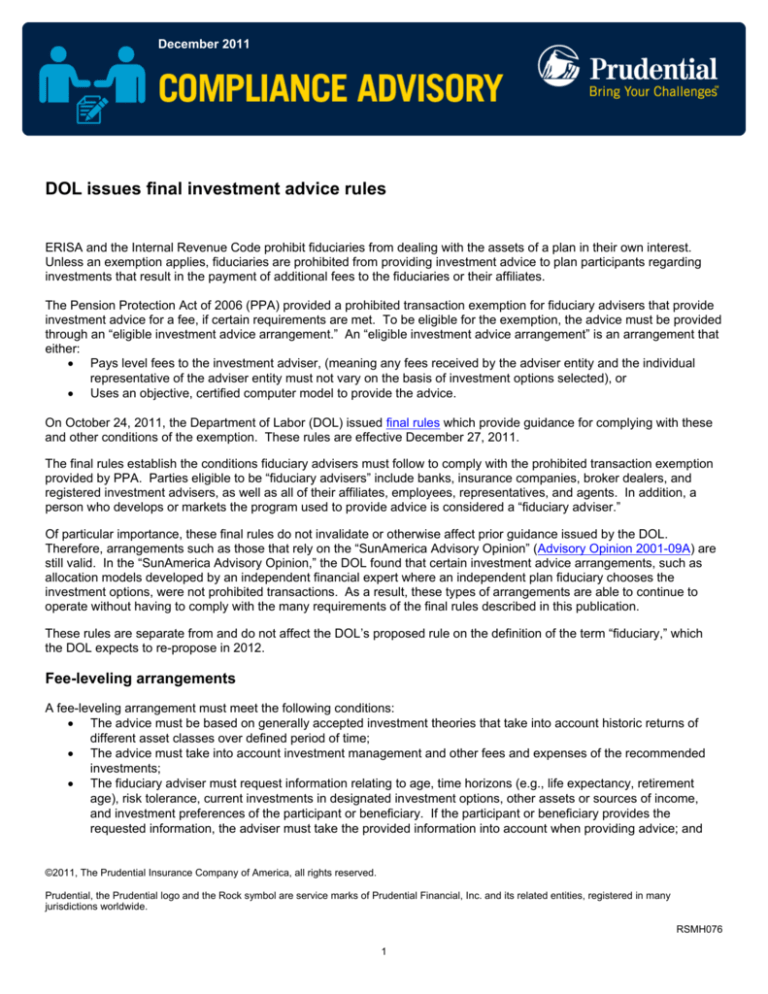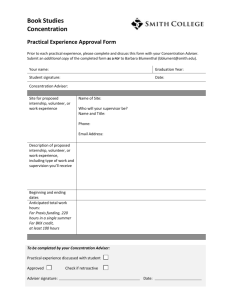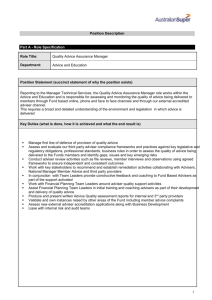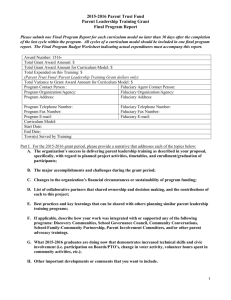
December 2011
DOL issues final investment advice rules
ERISA and the Internal Revenue Code prohibit fiduciaries from dealing with the assets of a plan in their own interest.
Unless an exemption applies, fiduciaries are prohibited from providing investment advice to plan participants regarding
investments that result in the payment of additional fees to the fiduciaries or their affiliates.
The Pension Protection Act of 2006 (PPA) provided a prohibited transaction exemption for fiduciary advisers that provide
investment advice for a fee, if certain requirements are met. To be eligible for the exemption, the advice must be provided
through an “eligible investment advice arrangement.” An “eligible investment advice arrangement” is an arrangement that
either:
• Pays level fees to the investment adviser, (meaning any fees received by the adviser entity and the individual
representative of the adviser entity must not vary on the basis of investment options selected), or
• Uses an objective, certified computer model to provide the advice.
On October 24, 2011, the Department of Labor (DOL) issued final rules which provide guidance for complying with these
and other conditions of the exemption. These rules are effective December 27, 2011.
The final rules establish the conditions fiduciary advisers must follow to comply with the prohibited transaction exemption
provided by PPA. Parties eligible to be “fiduciary advisers” include banks, insurance companies, broker dealers, and
registered investment advisers, as well as all of their affiliates, employees, representatives, and agents. In addition, a
person who develops or markets the program used to provide advice is considered a “fiduciary adviser.”
Of particular importance, these final rules do not invalidate or otherwise affect prior guidance issued by the DOL.
Therefore, arrangements such as those that rely on the “SunAmerica Advisory Opinion” (Advisory Opinion 2001-09A) are
still valid. In the “SunAmerica Advisory Opinion,” the DOL found that certain investment advice arrangements, such as
allocation models developed by an independent financial expert where an independent plan fiduciary chooses the
investment options, were not prohibited transactions. As a result, these types of arrangements are able to continue to
operate without having to comply with the many requirements of the final rules described in this publication.
These rules are separate from and do not affect the DOL’s proposed rule on the definition of the term “fiduciary,” which
the DOL expects to re-propose in 2012.
Fee-leveling arrangements
A fee-leveling arrangement must meet the following conditions:
• The advice must be based on generally accepted investment theories that take into account historic returns of
different asset classes over defined period of time;
• The advice must take into account investment management and other fees and expenses of the recommended
investments;
• The fiduciary adviser must request information relating to age, time horizons (e.g., life expectancy, retirement
age), risk tolerance, current investments in designated investment options, other assets or sources of income,
and investment preferences of the participant or beneficiary. If the participant or beneficiary provides the
requested information, the adviser must take the provided information into account when providing advice; and
©2011, The Prudential Insurance Company of America, all rights reserved.
Prudential, the Prudential logo and the Rock symbol are service marks of Prudential Financial, Inc. and its related entities, registered in many
jurisdictions worldwide.
RSMH076
1
December 2011
•
The fiduciary adviser may not receive from any party, directly or indirectly, any fee or compensation that varies
based on the participant’s or beneficiary’s selection of an investment option. Compensation includes
commissions, salary, bonuses, awards, promotions, or other things of value. A compensation or bonus
arrangement that is based on the overall profitability of an organization may be permitted under certain
circumstances.
Fee-leveling arrangements must also meet the authorization, audit, disclosure, and record retention provisions described
below.
Computer model arrangements
Arrangements using computer models to provide advice to participants and beneficiaries must meet the following
conditions:
• The model must be designed and operated to apply generally accepted investment theories that take into account
the historic risks and returns of different asset classes over a defined period of time;
• The model must take into account investment management and other fees and expenses of the recommended
investments;
• The model must appropriately weight the factors used in estimating future returns of investment options;
• The model must request from participants and beneficiaries information relating to age, time horizons, risk
tolerance, current investments in designated investment options, other assets or sources of income, and
investment preferences. If participants and beneficiaries provide the requested information, the model must take
the information into account;
• The model must use appropriate objective criteria to provide asset allocation portfolios comprised of investment
options available under the plan;
• The model must avoid investment recommendations that inappropriately favor investment options offered by the
fiduciary adviser over other investment options, or inappropriately favor investment options that generate greater
income for the adviser;
• The model must take into account all designated investment options (including employer securities and target
date funds) without giving inappropriate weight to any investment option. In-plan annuity options may be
excluded from the model. If in-plan annuity options are excluded from the model, participants and beneficiaries
must receive information about those options at the same time the model is furnished. If requested by the
participant or beneficiary, an investment option (such as employer securities or target date funds) may be
excluded from the modeled advice; and
• Before using the computer model, the fiduciary adviser must obtain a written certification from an “eligible
investment expert” that the model meets these conditions.
Computer model arrangements must also meet the authorization, audit, disclosure, and record retentions provisions
described below.
For these purposes, brokerage windows, self-directed brokerage accounts, and similar arrangements are not considered
designated investment options.
Authorization by a plan fiduciary
The investment advice arrangement must be authorized by a plan fiduciary other than the person offering the
arrangement, any persons providing designated investment options under the plan, or an affiliate of either party.
Annual audit requirement
At least annually, the fiduciary adviser must engage an independent auditor to conduct an audit of the arrangement to
ensure compliance with these rules. Within 60 days of completing the audit, the auditor must issue a written report to the
fiduciary adviser and to the fiduciaries that authorized the arrangement.
©2011, The Prudential Insurance Company of America, all rights reserved.
Prudential, the Prudential logo and the Rock symbol are service marks of Prudential Financial, Inc. and its related entities, registered in many
jurisdictions worldwide.
RSMH076
2
December 2011
Disclosure to participants
Before providing the advice, and annually thereafter, the fiduciary adviser must give participants and beneficiaries a
written notice describing:
• The role of any party that has a material relationship with the fiduciary adviser in the development of the program
and the selection of investment options available under the plan;
• The past performance and historical rates of return of the designated investment options available under the plan,
if not otherwise provided;
• All fees or other compensation the fiduciary adviser or affiliates receive in connection with the advice, investment
activity, or rollover of plan assets or investment of plan distributions;
• Any material relationships of the adviser or affiliates in security or other property;
• The manner and circumstances in which the participant or beneficiary information will be used;
• The types of services provided by the fiduciary adviser in connection with the provision of investment advice;
• That the adviser is acting as a fiduciary of the plan in providing the advice; and
• That the participant or beneficiary may separately arrange for the advice by another adviser that could have no
material affiliation with and receive no fees or other compensation in connection with the security or other
property.
This notice must be written in a manner to be understood by the average participant. It may be provided electronically if it
satisfies the DOL’s standard rules for electronic delivery. Fiduciary advisers may use the model disclosure provided in the
final rules.
Disclosure to authorizing fiduciary
In addition, the fiduciary adviser must provide the authorizing fiduciary with a written notice that the adviser intends to
comply with the conditions of the exemption, that the investment advice arrangement will be audited annually, and that the
auditor will furnish a copy of the findings within 60 days of completing the audit.
Additional conditions
The fiduciary adviser must provide appropriate disclosure in connection with investment activity as required by securities
laws. The investment activity must occur solely at the direction of the participant or beneficiary, the compensation
received by the fiduciary adviser must be reasonable, and the terms of the investment activity must be at least as
favorable to the plan as an arm’s-length transaction.
In addition, the fiduciary adviser must generally keep records demonstrating compliance with these rules for at least six
(6) years after the advice is provided.
Effective date and next steps
This guidance is effective on December 27, 2011, and is applicable to transactions that occur on or after that date.
Sponsors of participant-directed defined contribution plans should ensure that any investment advice provided to
participants and beneficiaries after that date either meets the requirements of the final rules or complies with ERISA
through an arrangement that does not require a prohibited transaction exemption.
©2011, The Prudential Insurance Company of America, all rights reserved.
Prudential, the Prudential logo and the Rock symbol are service marks of Prudential Financial, Inc. and its related entities, registered in many
jurisdictions worldwide.
RSMH076
3




![Literature Option [doc] - Department of French and Italian](http://s3.studylib.net/store/data/006916848_1-f8194c2266edb737cddebfb8fa0250f1-300x300.png)




